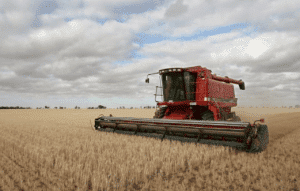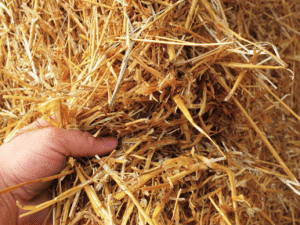

Ideally, you would be able to find a source for long straw bales in your area. This means straw stalks that are roughly 2′ long or longer within the bale. In order for this to be possible, your farmer would need to be growing from heritage seeds, not the more modern, “domesticated” crops, and they would need to harvest with a low-cut sickle mower rather than a rotary combine harvester. This really narrows down the source to a few, small-scale farmers in most areas. If you can’t find that farmer, then be sure to find the bales containing the longest straw within them that you can find in your area. The impact of the longer straw is worth the effort of searching as your walls will be tighter, easier to get straight, more energy efficient, and stronger over all.



11 Responses
Could we also facing problems with genetic modification and the use of herbicides and pesticides, that is sprayed on the wheat during it’s growth, Therefor bringing toxins into the home.
The pesticides can certainly be an issue. I have not seen any research on what residue is left over after the straw is baled, but I imagine there is a chance it would be contaminated. That said, once plastered, I don’t see it being an issue as the walls are sealed tightly against any movement of solids like pesticide residue.
Thanks for the information. I thought I noticed that wheat seemed shorter than I remembered as a child. I thought it was because I had grown, but you cleared that up substantially.
What is the best type of bale to use? How is flax straw? Or maybe oat straw?
I have not used flax straw, personally. I can say that any straw that is local to you that fits the details of dry, uniform in shape, LONG individual stalks within the bale, tight, and free of water damage is a good option. It’s more about the quality of the bale than the type of grain it comes from.
We are looking to buy straw bales for our house soon and we have two offers on the table. The first offer is very local (within 5 miles) with tight metal wire, wheat straw bales. The bales look good in all ways except that the straw we pulled out was in the 4-6″ range. The second offer is from 30 miles away, it is oat straw with tight poly twine, and 12-14″ stalks. These bales look good as well. Price is the same. Which would you go with? Exactly what issues do you run into with shorter stalks? Does it make re-tying bales a lot more difficult?
Without question I would go with the oat bales. Longer stalks make notching, retying, and over all wall strength better and make stuffing the window and door shapes as well as plastering easier too. Further, wire ties are a pain to work with and are dangerous when hit with a chainsaw by accident. Happy baling!
I’m looking to build a 6 foot retaining wall with straw bales, faced with chain-link fence, and reinforced with painted rebar. Everything will be linked together with zip ties. I will backfill with ordinary dirt from a nearby road project. Everybody says I’m crazy, because it will rot away and I will lose my yard to the river again. But I think the EPA might have more objection to a cinder block wall. Do you think this is so, and more importantly, am I crazy?
Hi Jamie. I won’t call you crazy, but I don’t recommend the use of bales underground in any capacity. They will rot in time and you’ll be left with a hollow space inside the wall. You won’t know the extent of the rot until it fails, which could be a bigger problem. You can consider a rock barrier/wall, or a tried and true retaining wall from poured cinder block or dry-stack retaining walls. They may be harder to win approval for, but if that’s in question, I imagine that the EPA would have issue with anything you place in the way. If that’s the case, then it’s a good idea to provide them with the best option for long term use and lifecycle. Good luck!
What are your thoughts are trying cornstalk (straw bale) for slip straw construction? Has anyone done this that you know of, if so, how did it turn out?
Cornstalk bales are VERY bulky, which makes resizing them difficult. I am not sure about their R-value either as the larger material and bulkier bales will no doubt have an impact on the numbers. Let me know if you use them. I have worked with them once and found them cumbersome, but ultimately (after a few extra swear words) functional!